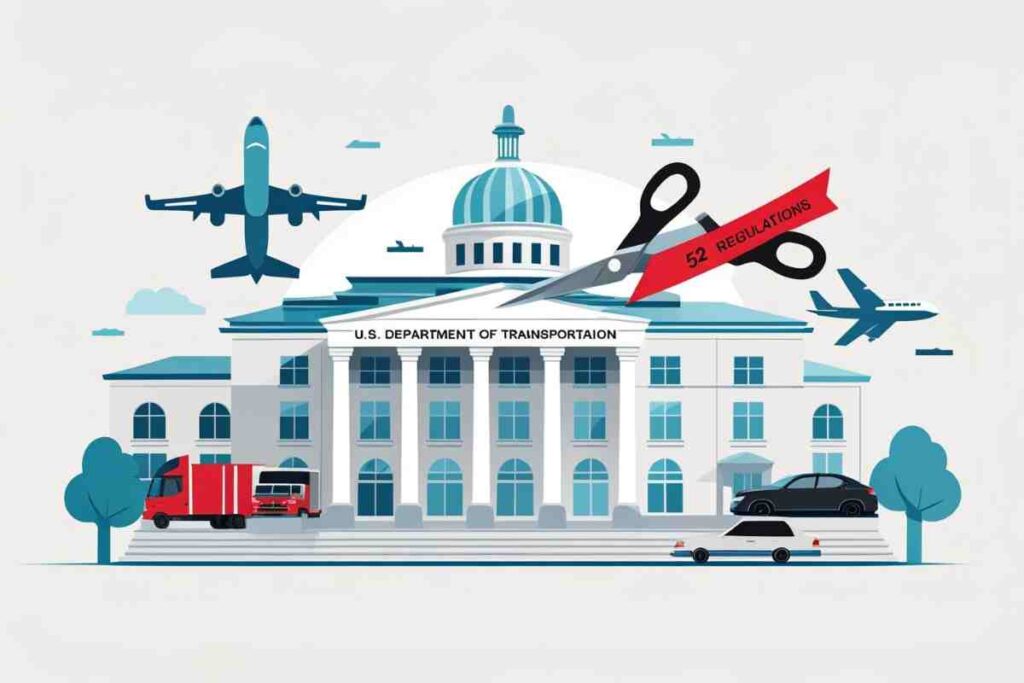The U.S. Department of Transportation USDOT eliminates 52 regulations in a sweeping move aimed at cutting red tape and streamlining transportation rules. While some see this as a win for efficiency and lower costs, others worry about potential safety risks and long term consequences.
This breakdown covers what rules were cut, why they matter, who is most affected, and how the future of U.S. transportation may be shaped by this regulatory rollback.
What Does It Mean When USDOT Eliminates 52 Regulations?
When the USDOT says it eliminated 52 regulations, it does not mean dozens of safety laws vanished overnight. Instead, it refers to:
- Outdated rules removed from the books.
- Duplicate regulations merged or simplified.
- Paperwork-heavy processes streamlined with technology.
- Obsolete compliance requirements no longer enforced.
The USDOT’s elimination of 52 regulations primarily targeted outdated, duplicate, or overly burdensome rules, aiming to reduce costs, encourage innovation, and speed up operations without compromising safety.
Why Did USDOT Decide to Cut These Rules?
Several reasons drove this decision:
- Reduce Costs for Businesses
Compliance can cost companies millions in paperwork and legal fees. Eliminating redundant rules means less money wasted. - Encourage Innovation
Old regulations sometimes force industries to use outdated methods. Cutting them clears the way for new tech. - Cut Government Waste
Fewer rules mean fewer hours spent by agencies managing unnecessary regulations. - Support Economic Growth
Transportation is the backbone of the U.S. economy. Streamlined processes mean faster movement of goods and services.
Which Industries Are Most Affected?
Trucking and Commercial Vehicles
- Outdated paperwork for inspections eliminated.
- Duplicate hazardous material transport forms removed.
- Simplified compliance with electronic logging devices (ELDs).
Less time on forms, more time on the road.
Airlines and Aviation
- Maintenance reporting streamlined.
- Old training requirements updated to modern standards.
Airlines save time and money while maintaining safety.
Railroads
- Duplicate inspection rules cut.
- Overlapping federal and state checks reduced.
Faster operations without compromising oversight.
Everyday Drivers
- Some regulations simplified at the state level.
- Vehicle safety checks aligned with modern standards.
Minimal for individuals, but lower costs could trickle down in cheaper goods and services.
Benefits of Eliminating Regulations
On paper, cutting 52 rules offers several clear benefits:
- Lower costs: Businesses save money, possibly reinvesting in growth or employee pay.
- Faster operations: Reduced red tape shortens delivery times.
- Innovation boost: New tech adoption becomes easier.
- Less government waste: Agencies can focus on meaningful oversight.
Risks and Concerns of Deregulation
Not everyone agrees this move is positive. Critics point out:
- Corporate shortcuts – Less oversight could mean cutting corners.
- Accountability issues – Fewer paper trails make legal enforcement harder.
- Long-term consequences – Environmental and public safety risks may surface years later.
Real-World Examples of Regulatory Cuts
Example 1: Trucking Logs
Old rules required drivers to log hours twice in separate systems. By cutting duplicates, truckers save hours weekly while ELDs still track safety.
Example 2: Aviation Training
Pilots no longer need to train on outdated equipment, focusing instead on modern systems.
Example 3: Rail Safety Inspections
Railroads now face streamlined inspections that reduce delays while maintaining strict federal standards.
Expert Perspectives
- Business groups applaud the move as a relief from excessive red tape.
- Safety advocates caution that any deregulation must prioritize human lives first.
- Policy experts argue that regulations should evolve with technology rather than be blindly cut.
What This Means for the Future of U.S. Transportation
Looking ahead, three trends stand out:
- New Technology, New Rules
Self-driving trucks, drones, and AI logistics will demand fresh regulations. - Public Opinion Matters
If deregulation sparks safety issues, public pressure may force stricter rules again. - Finding Balance
Too many rules can slow progress. Too few can risk lives. The future depends on striking the right balance.
Actionable Steps for Businesses and Drivers
- Stay Informed: Monitor USDOT updates to avoid compliance surprises.
- Invest in Technology: Tools like ELDs or AI-driven fleet management help stay ahead.
- Focus on Safety: Even if paperwork is reduced, companies should maintain strict internal safety checks.
- Engage in Policy: Industry groups can lobby for smarter, not weaker, regulations.
FAQs
What does it mean that USDOT eliminated 52 regulations?
It means outdated, duplicate, or unnecessary rules were cut or simplified to reduce costs and speed up processes.
Will deregulation make transportation less safe?
Not necessarily. Safety-critical rules remain in place, but critics worry that fewer regulations could create accountability gaps.
How will truck drivers benefit from this change?
Truckers spend less time on duplicate paperwork, allowing more focus on driving and efficiency.
Do these changes affect everyday drivers?
Yes, but indirectly. Simplified rules for companies may reduce shipping costs, which could lower prices for consumers.
What’s the biggest long-term concern?
That cost savings today could lead to safety or environmental problems tomorrow if oversight weakens.
Conclusion
The USDOT eliminates 52 regulations is a bold step toward streamlining U.S. transportation. While businesses welcome reduced red tape, safety advocates warn that lives are at stake if deregulation goes too far.
The bottom line? Regulations should evolve, not disappear. Cutting outdated rules makes sense, but continuous oversight is key to keeping transportation safe, efficient, and innovative.





